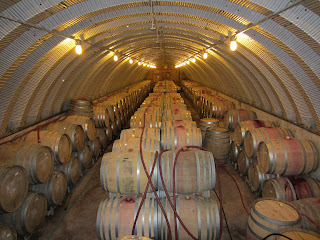The Niagara Peninsula in Ontario has a lot going for it. Sure, it is one of the most marginal and challenging climates for growing wine grapes, but it was so many other assets at it's disposal. For one, as a cool-climate region it is poised to capitalise on the increased interest in cool-climate food-friendly wines both domestically and overseas. They have also garnered serious attention for their ice wines, trumping some famous European regions in a number of competitions. The Niagara Peninsula is also conveniently located only an hour or so from Toronto (their biggest market), right next to one of the biggest tourist attractions in North America (Niagara Falls), and less than a days drive to over 50% of the US population. Their agritourism is some of the most sophisticated I have seen outside of California, and they are doing pretty well. If only they could have more consistent vintages...
No different to many regions in North America, the Niagara Peninsula has a lot of new wineries. The oldest existing wineries go back to the '70s, but most have been established in the last 15 years. One of these is Malivoire Wines, founded in 1995 by Martin Malivoire, a former Hollywood special effects expert. Looking for stability and a chance to be close to home he and wife Moira established the winery on a former orchard, building a gravity-fed winery into the side of a hill. The winery and most vineyards are located in the Beamsville Bench sub-region of the Niagara Escarpment, benefiting from aspect, elevation and protection from wind. The initial focus was on Burgundian varieties of chardonnay, pinot noir and gamay, but they have since expanded to included fuller reds and rieslings, identifying market trends and regional performers. They are best known for their Ladybug Rose, the 2010 being bone-dry with a nice savoury strawberry character, good balance without being too simple. It was interesting to hear how the Niagara Escarpment was formed, and also to see the influence on the winery that a special effects expert had. The cellar in particular felt like a futuristic army barracks.
With the weather deteriorating I headed further along the Escarpment to Hidden Bench Vineyards and Winery. The mission here is pretty simple; to make world-class wines. Having tasted through most of the wines I would have to say they are doing a pretty good job of this. Their wines express unique terroir and varietal harmony, and whilst not in everyone's price bracket should be held up to show the immense potential of the region. The tasting room was lovely and warm (nice and quiet, too), so it was great to taste and ask questions of the very knowledgeable Jennifer. There are two ranges in the portfolio, the Estate Series and Terroir Series, which are understandably in much smaller volumes. Here were the standout wines for me;
Hidden Bench Tete de Cuvee Chardonnay 2008 - very bold bright peach and lime fruit, with a complex floral and pear nose. The palate is very rich and layered, yet quite light and clean. Citrus complexity and balance would be even better with food.
Hidden Bench Locust Lane Pinot Noir 2008 - dark cherry and game notes combine to create a very savoury fruit nose. Subtle yet opulent and rich, silky and soft. Hits an amazing sweet spot between fruit and savoury elements rarely achieved in new world pinot noir, but very youthful.
After some hearty pea and ham soup generously provided by my hosts at Hidden Bench, I headed off gleefully in actual snowfall. Further up the hill is Fielding Estate, which boasts a fantastic view out of the tasting room over the vineyards. The modest production covers a range of varieties, and includes a sparkling riesling. Working with so many varieties offers the opportunity to blend, and several white and red blends are produced. The range in general offer great value to consumers who may be new to wine, as they are very clean and precise wines, reflective of varietal character. They do lack interest, which in general you have to pay a bit more for.
Tawse Winery boasts old world inspiration and new world perfection, which is quite an absolute statement to make. It's not without merit though, as the wines are on the non-traditional side of new world, going for texture and mouthfeel rather than obvious varietal character. The white wines were the most impressive for me, including a range of single vineyard chardonnays and rieslings. Riesling in particular seems to do very well in this area, particularly the Tawse Estate Riesling 2010, exhibiting delicious ripe grapefruit characters. The red wines were perhaps products of their vintage, as they were unripe and a bit sour. The ice wines were both outstanding; an oaked chardonnay having great volume and a caramel edge, and a riesling which was reminiscent of quince paste. I discovered as I was writing this post that a tawse is actually a corporal punishment implement used in Scottish schools. I'm not sure if there is a connection.
That evening I just happened to be walking down by the famous Falls, and fireworks just happened to be going off. Here are a few photos, which whilst not great in quality show how amazing this sight was.
Click here to see more photos from Day 1 of the Niagara Peninsula








No comments:
Post a Comment